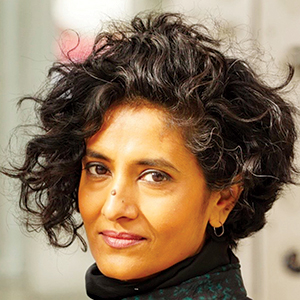

Thirty years after Somini Sengupta left India as a child, she returned to work as the New Delhi Bureau Chief for the New York Times. She was the first reporter of Indian descent ever assigned to the post and, in the process, Sengupta discovered a brilliant way to rediscover her own roots while documenting the future of Indian kids and their predicaments at the same time.
The result is a fantastic new book, The End of Karma: Hope and Fury Among India’s Young, in which Sengupta weaves the results of her own journey, both personal and journalistic, into the trajectories of seven different Indian youth cases, creating a tapestry with the author/journalist as the observer/participant. Sengupta is the common thread, and she refreshingly shatters all divisions between the objective and the subjective. Forget all that stuff about the reporter staying at a distance from the story. That wasn’t going to work in this case. In fact, it made the book better and I’m glad I showed up when Sengupta came to speak at a Commonwealth Club event in Santa Clara a few weeks ago.
With 365 million people between the ages of 10 and 24, and a million turning 18 every month, India can be understood as the youngest country in the world, ever, and Sengupta’s book is about them: the kids, their aspirations and, more importantly, their obstacles in a society still deeply ingrained with class and gender inequalities.
Building on that foundation, Sengupta takes inspiration from Salman Rushdie, who famously wrote about ‘Midnight’s Children,’ those born around the time of India’s independence in 1947. Following Rushdie’s lead, Sengupta refers to the current-day generation of youth as ‘noonday children,’ who are now vastly important in rewriting India’s freedom story. ‘It is a tipping point generation in the arc of independent India’s history,’ Sengupta writes. ‘It makes new demands on India’s democracy in at least three important ways: genuine equality of opportunity, dignity for girls, and civil liberties. It pushes India to keep its promise.’
The promise and aspirations of this generation, and where they fail, are what drive the interconnected chapters. In one instance, the sheer amount of kids streaming into school dwarfs the numbers from decades ago. Another chapter features India’s indigenous people, the adivasis, who comprise 8 percent of India’s population. There we find Mani, who escapes the jungle wasteland to become a live-in maid, and at the polar opposite place, Gurgaon, a gated community, a ‘manicured paradise,’ a ‘Xanadu of a new Indian imagination.’
Both Maoist rebels and Prime Minister Modi are likewise given their due. We get to see a young female warrior, a communist insurgent hit-woman who provides an insider’s perspective on the recruitment process the guerrillas use to target throngs of illiterate jungle youth. In the very next chapter, we see how Modi took a huge portion of Obama’s playbook on grassroots social media organizing to target millions of young people. As a result, the right wing Hindu nationalists rose to power in unexpected proportions.
Speaking of social media, another chapter uses Facebook to show just how backward India is in regards to free speech. Two girls get arrested for criticizing an organization on Facebook, prompting a national debate over the right to free expression in a networked age.
With each story in the book, Sengupta cycles back to India’s independence, its constitution and one of that document’s primary architectsÑsocial reformer Bhimrao Ambedkar. She seems to take just as much inspiration from Ambedkar as she does Rushdie. Not a bad combo.
Framing The End of Karma, the story shows Sengupta’s own life-adventure functioning as a hall of mirrors. She worked various jobs after coming of age in the U.S. but never felt satisfied with the sedentary life. It was not until becoming a reporter that she found her calling. ‘This is where I discover I can make a living to-ing and fro-ing, poking my head into one world, then another, having to belong to none,’ she writes. ‘Cognitive dissonance becomes my travel mate. I become a journalist. I am a fish in water. Home.’



